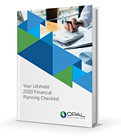How to Invest During Volatile Markets
By Jesse Giordano, CFP® | September 24, 2019A sound investment plan is one of the greatest tools we have for growing our wealth over the long term. This requires staying disciplined and committed (in good times and bad), but sticking with it during market downturns is sometimes easier said than done.
Market turbulence can shake even the most confident investor, but take heart in knowing that the volatility is normal and downturns are typically short. In fact, slumps are historically followed by upswings and recovery. Reacting emotionally to volatile market conditions and pulling out your investments will likely come back to bite you.
This is precisely why we generally recommend staying invested versus trying to time the market. If fear nudges you to sell, you’ll put yourself on the sidelines and may miss out on the recovery. History shows that missing even a few of the best market days is enough to significantly undermine your performance in the long run.
To be clear, that doesn’t mean sitting back and doing nothing. What you want is to take measured, decisive action to protect your investments through fluctuating markets. Here’s how.

Focus on Your Long-Term Goals
Working toward down-the-line financial goals requires us to take the long view. Shorter-term goals, like taking a family vacation or closing the deal on a rental property, for instance, are best funded by cash reserves, bonds or a surplus of regular monthly income—think: easy-to-tap capital.
Funding long-term goals is different. Liquidity isn’t an issue since you won’t need to access the funds for quite a while. Goals in this category include things like padding your nest egg, your kids’ college funds and so on. With these types of goals, you have one very valuable asset on your side: time. It goes without saying that setting aside cash for these targets in a regular savings account is generally unwise. The best you can hope for is to earn maybe 3 percent on your money.
Staying invested in the market is far and away the best way to go—despite up and down cycles—since the average annual rate of return of the S&P 500 since inception is about 10 percent.
Rebalance Your Portfolio
Your portfolio isn’t a fixed thing, but rather an evolving part of your financial life that reflects those long-term goals we just talked about. A key component of mitigating your risk and putting yourself in the best financial position is tweaking your portfolio along the way.
This is where diversification comes in. What will you do if all your investments are concentrated on one sector that goes through an unexpected rough patch? If you aren’t diversified, it could be enough to majorly dent your returns. Shoring up your portfolio also has to do with making sure you’re invested in an appropriate mix of different types of assets such as stocks, bonds, and alternative investments.
This brings us to the importance of periodically rebalancing your portfolio. In light of recent market volatility, is your asset allocation on track for where you are in relation to your long-term goals? The answer will vary depending on a number of factors, including your risk tolerance (i.e. how comfortable you are with the unknown), time horizon, and financial situation. Your personality and past experiences dictate your core tolerance for risk, and it greatly informs your ability to roll with the punches of market swings.
Regardless, asset allocation tends to get thrown off when the market goes through a downward spell, so revisiting things with an experienced wealth advisor can help right the ship.
Make a Plan Based on Your Cash Flow Needs
If you’re a Millennial or Gen Xer, it’s actually a great opportunity to take advantage of market drops when prices are low and gain potentially better long-term returns. Remember: you’ve got more time ahead of you to stay invested, giving you more space to bounce back after a slump.
The story is different, however, for folks who are nearing retirement. This is the time to reduce risk by moving away from stocks. If you’re planning on leaving the workforce relatively soon, your portfolio may not have time to recover from a significant market dip. Similarly, retirees are especially at risk during periods of market stress. Consider reducing equity exposure, building cash reserves, and protecting against sequence risk.
The thing to remember is that none of us knows what the future holds when it comes to predicting market behavior. Those who are not nearing retirement generally have more time to ride out turbulence and reap the rewards of market recovery later down the line.
No matter what life stage you’re at, checking in on your portfolio, cash flow needs and long-term goals should be at the top of your to-do list during volatile times. It’s complex stuff, but Opal Wealth Advisors can demystify the details and get you on solid footing.
Be a Smart Investor
Stay up-to-date with industry-leading information and news delivered straight to your inbox.
Get our timely insights delivered to your inbox (Blog)
Please remember that past performance may not be indicative of future results. Different types of investments involve varying degrees of risk, and there can be no assurance that the future performance of any specific investment, investment strategy, or product (including the investments and/or investment strategies recommended or undertaken by Opal Wealth Advisors, LLC [“OWA]), or any non-investment related content, made reference to directly or indirectly in this commentary will be profitable, equal any corresponding indicated historical performance level(s), be suitable for your portfolio or individual situation, or prove successful. Due to various factors, including changing market conditions and/or applicable laws, the content may no longer be reflective of current opinions or positions. Moreover, you should not assume that any discussion or information contained in this commentary serves as the receipt of, or as a substitute for, personalized investment advice from OWA. OWA is neither a law firm, nor a certified public accounting firm, and no portion of the commentary content should be construed as legal or accounting advice. A copy of the OWA’s current written disclosure Brochure discussing our advisory services and fees continues to remain available upon request or at www.opalwealthadvisors.com. Please Remember: If you are a OWA client, please contact OWA, in writing, if there are any changes in your personal/financial situation or investment objectives for the purpose of reviewing/evaluating/revising our previous recommendations and/or services, or if you would like to impose, add, or to modify any reasonable restrictions to our investment advisory services. Unless, and until, you notify us, in writing, to the contrary, we shall continue to provide services as we do currently. Please Also Remember to advise us if you have not been receiving account statements (at least quarterly) from the account custodian.



